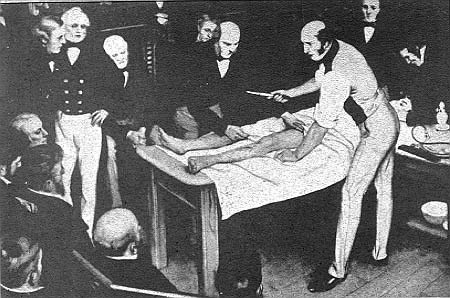
Robert Liston (1794-1847) was a Scottish surgeon, known for his anatomical knowledge, skill and fast hands. Liston was famous – and to some extent notorious – for the speed of his amputations. It was said he could remove a leg in well under a minute, an astonishing feat at a time when amputations involved a lot of laborious hacking and sawing.
Liston’s speed often came at a cost, however. According to legend, he once accidentally slashed the fingers of an assistant – and both the patient and the assistant later died of gangrene. Liston was also said to have accidentally sliced off a man’s testicles while amputating his leg at the thigh.
Between 1818 and 1840, when he relocated to London, Liston worked in private practice in his native Edinburgh. Other physicians loathed him for his short temper and sharp tongue. Liston’s willingness to treat the poor made him more popular with ordinary Scots, though he had a reputation for impatience and carelessness.
“About the age of nine or ten [the patient] had incontinence of urine and was frequently chastised by his parents on account of this occurrence during the night [bedwetting]. In order to save himself from a flogging, before going to bed he passed a brass curtain ring over the penis, as far as he could. This expedient had the desired effect, but in the morning swelling had come on [and prevented] his removing it. Notwithstanding all his suffering from pain and difficulty in passing his urine, he made no complaint.”
The curtain ring remained lodged at the base of his penis for 47 years. Eventually it sank into the skin which, according to Liston, “adhered over the foreign body, and there it remained”. Strangely, the foreign body gave the patient no significant trouble, a fact evidenced by him becoming “the father of a fine family”.
Seeking to resolve the man’s continence issues, Liston examined him and found a “broad hard substance” around the base of his member. Not one to mess around, the doctor set to work incising and separating skin from the lower penis. After much work Liston managed to extract the brass ring, which after almost five decades had become encrusted with calculus (hard growth formed by salt and urea deposits). The operation brought some improvement to the man’s urinary issues but he died of lung disease shortly after.
Source: Robert Liston, “Account of a calculus in the urethra, formed upon a brass ring” in Edinburgh Medical and Surgical Journal, vol. 19, 1823. Content on this page is © Alpha History 2019-23. Content may not be republished without our express permission. For more information please refer to our Terms of Use or contact Alpha History.
